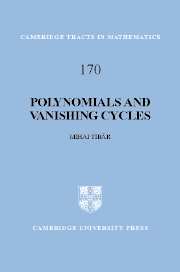Book contents
- Frontmatter
- Contents
- Preface
- PART I Singularities at infinity of polynomial functions
- PART II The impact of global polar varieties
- 6 Polar invariants and topology of affine varieties
- 7 Relative polar curves and families of affine hypersurfaces
- 8 Monodromy of polynomials
- PART III Vanishing cycles of nongeneric pencils
- Appendix 1 Stratified singularities
- Appendix 2 Hints to some exercises
- Notes
- References
- Bibliography
- Index
7 - Relative polar curves and families of affine hypersurfaces
from PART II - The impact of global polar varieties
Published online by Cambridge University Press: 29 September 2009
- Frontmatter
- Contents
- Preface
- PART I Singularities at infinity of polynomial functions
- PART II The impact of global polar varieties
- 6 Polar invariants and topology of affine varieties
- 7 Relative polar curves and families of affine hypersurfaces
- 8 Monodromy of polynomials
- PART III Vanishing cycles of nongeneric pencils
- Appendix 1 Stratified singularities
- Appendix 2 Hints to some exercises
- Notes
- References
- Bibliography
- Index
Summary
Local and global relative polar curves
Local polar curves stand as a key device, relating algebro-geometric properties to topological properties. They have been systematically used in the study of complex analytic spaces and of holomorphic functions in the 1970s by Kleiman, Lê, Hamm, Teissier, Merle, e.g. in [Kl, HmL1, Lê5, LêTe, Te2, Te3, Me]. Many other authors developed this study and found more and more applications of polar curves.
In the preceding section we have discussed higher-dimensional polar loci of varieties. Polar curves appeared in §2 and §3. Here we focus on relative polar curves with respect to a given function on the space.
In the local setting, the local polar curve theorem, proved by Hamm and Lê in [HmL1, §2], states that, given a holomorphic function germ f : (ℂn+1,0) → ℂ, there exists a Zariski-open subset of linear forms l : (ℂn+1,0)→ ℂ such that the singular locus of the map germ (l, f) is a curve or it is empty. Lê D.T. also proved the following equisingularity result [Lê1]: if Singf is of dimension one, then the transversal singularity is μ-constant if and only if the generic local polar curve is empty. If this is the case, then Singf is a nonsingular curve germ. By a theorem due to Lê and Saito [LêSa], the absence of polar curve is equivalent to the Thom (af)-condition along the line Singf.
- Type
- Chapter
- Information
- Polynomials and Vanishing Cycles , pp. 108 - 129Publisher: Cambridge University PressPrint publication year: 2007



